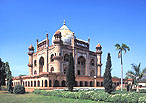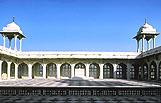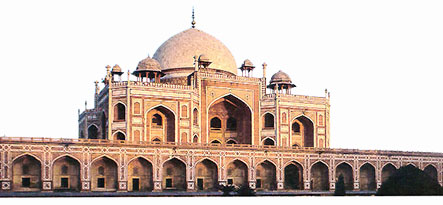
INDO-ISLAMIC
ARCHITECTURE, A CONCISE HISTORY
|

As the first Islamic monarchy in India, the Slave Dynasty (1206-1290), and all of its successors, the Khalji (1290-1320), the Tughluq (1320-1413), the Sayyid (1414-51), and the Lodi (1451-1526), consistently fixed Delhi as the capital and uniformly called their monarchs eSultan,f these dynasties are referred to as the eDelhi Sultanatef as a whole, to distinguish them from the later Muslim empire, the Mughals. The eArt of Delhi Sultanatef generally indicates the Muslim art that flourished for these 320 years in northern India.
Art of Delhi Sultanate was the process of absorption and Indianization of the techniques of art and architecture brought from the west, so archaic impressions are consequently unavoidable when comparing it to the Mughal art that followed, which is considered to be fully matured Indo-Islamic art.
The mosques from the Khalji onward, having acquired the techniques of Islamic architecture, were fundamentally of the arabian type with the plan of hypostyle oblong hall, but the Khirki Masjid (c.1375) presents a peculiar plan, having four courtyards like a Charbagh-style garden.
 ___________ ___________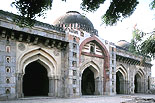 Plan of Khirki Mosque, and Moth-ki Mosque, Delhi The successive dynasties respectively constructed new capitals in the greater Delhi area, which would be called ethe seven cities of Delhi.f Among them, the Tughlq Dynasty constructed the third city, Tughlaqabad, with magnificent stone ramparts, to the east of the second city, Lal Kot, in which resides the Qutb district. The tomb (1325) of this dynastyfs sultan, Ghiyas al-Din, is a cubic structure of red sandstone crowned with a dome of white marble, becoming a model of later brilliant Mughal mausoleums in spite of its small scale.
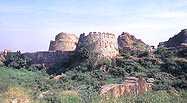 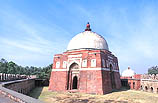 Tughluqabad Fort and Tomb of Ghiyas al-Din, Delhi
The Tughluqs also constructed in the far north the fifth city, Firozabad, of which only the ruins of the fort of Firoz Shah Kotla and a part of the Friday Mosque remain.
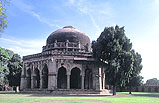 The Mausoleum of Sikandar Lodi in Lodi Park
Although stone carvings of Arabic calligraphy and arabesques of geometric or foliage patterns were well developed, miniature art, which could be regarded as idol worship, had yet to reach its maturity compared to Hindu and Jain art.
As for northern India, Gaur in the east, Jaunpur in the B>Ahmadabad in the west, and Mandu in the middle: these areas allowed their governors, who had been dispatched from the Delhi Sultanate, to become independent and they developed their own characteristic architectural styles, even though they remained under Delhifs deep influence. .
This is the ruin of a group of edifices consisting of the first Indian mosque and its annexed facilities, in the Mehrauli district in south Delhi. Qutb al-Din Aybak (?-1210), who had subjugated northern India as the general of Muhammad of Goli in Afghanistan, became independent in 1206 and established the first Islamic political regime of the Delhi Sultanate, the Slave Dynasty. He took the fortified town of Qila Rai Pithora, which had been constructed by the Hindu king, Pritvi Raj, settling it as his capital. Aybak dismantled twenty-seven Hindu and Jain temples of to erect the Friday Mosque at the site of a Vishnu temple, reusing their components.
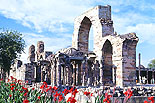 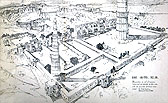 Qutb Masjid seen from west and Bird's-eye view. The mosque, later referred to as Quwwat-al-Islam Mosque (meaning Might of Islam), had a narrow oblong worship room with five domes in a row and a large longitudinal courtyard surrounded by cloisters. The succeeding Sultan, Shams al-Din Iltutmish, enlarged it on the left and right sides, to four times its total extent, in 1230. Then, Khalji Sultan, Alah al-Din (r.1296-1316), enlarged it further to the right and on the opposite side of Kibla to the extent of ten times of the earliest stage. However, Indian masons did not know the structural system of true arches and domes and constructed the mosque with the pseudo manner of corbelled domes. As a result, a line of twenty domes, which added up to 225m, all collapsed in later years and were carried away as materials for new buildings. One of the earliest mausoleums, Iltutmishfs Tomb (c.1235), has also lost its corbelled dome.
What is peculiar in this mosque is that an enormous Screen of arches was later erected in front of the worship hall, the existing part of which reaches an impressive height of 15m with a thickness of 2.6m.
  Iltutumish's Tomb and Qutb Minar Ala al-Din commenced constructing the Alai Minar on a twofold scale of the former Minaret in the largest courtyard in the course of the second expansion, but it was not completed, only leaving its basal part. At the new gate erected on this occasion, Alai Darwaza, Indian masons succeeded in erecting a true dome for the first time.
In the oldest courtyard stands an iron pillar 7.5m long (6.8m above ground), which is thought to have been produced by the king of Gupta Dynasty, Chandragupta II, in the 4th century. It was a Stambha (monumental pillar) dedicated to a Vishnu temple according to its inscription, and it seems to have been brought here before the Islamic conquest. This wrought iron pillar, with a Gupta-style capital on the top, is so highly refined that it has not suffered rust at all in spite of its exposure to the elements for 1,600 years. .
Gaur is the ruins of an ancient city spreading over the border between West Bengal in India and Bangladesh. It represents Islamic architecture in Bengal along with the ruins of Pandua 30km to the north.
The city was ruled by a Sultan who gained independence from Delhi, and who relocated of the capital from Pandua to here in 1443. Gaur thrived so much until the middle of the 16th century that the Mughal emperor Humayun called it Jannatabad (City of Paradise).

The region of Bengal is an alluvial plain lacking stone and so bricks have been used as the main building material. Although there are some cases in which brick walls were finished with stone panels, as at Chota Sona Mosque (1493-1519) and Bara Sona Mosque (1526), most buildings exposed bare bricks. When they were ornamented, it took the form of terracotta panels carved in relief in each period, from ancient Buddhist architecture and passing those techniques to Hindu temples in the early modern times. Their upward curved eaves imitating that of farmhouses in pluvial Bengal, the purpose of which was to shed rain fast, generated a graceful roof-shape (Bangaldar Roof), on the buildings of Bengal. This shape influenced not only later Hindu temples in Bengal, but also Rajput architecture in western India through Delhi.
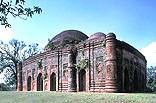 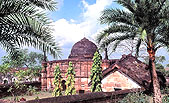 Lattan Masjid and Qadam Rasul Masjid
As for mosques, the general form is the standing-alone worship-hall type without a courtyard, represented by the Lattan Mosque (end of the 15th century). One can hardly distinguish this characteristic type of single-dome mosque from similar scale mausoleums in terms of appearance. .
Ahmadabad is the principal city in Gujarat State, western India. It developed as an Islamic city from the 15th century to the 18th. During the British colonial period, it was known as eManchester in Indiaf owing to its prosperous cotton textile industries, then in the later half of the 20th century, it was called the eMacca of Modern Design in India.f
Its history began when Muzaffar Khan, governor of Gujarat, who had been dispatched from the Tughluq Dynasty of the Delhi Sultanate, declared independence in 1407 and his grandson, Ahmad Shah I (r. 1411-42), founded the capital, giving it his name, Ahmadabad, in 1411. The name of the dynasty was referred to as the Ahmad Shahi Dynasty, which was also taken from his name, indicating his position as the substantial founder of the sultanate.
  Ahmad Shah Masjid and Jami Masjid's Interior
The first mosque, Ahmad Shahfs Mosque (1414), was the type of hypostyle hall that used columns taken from existing temples together with new ones. It was constructed in a wooden-like post and beam structure without using arches except for openings facing the courtyard and the Mihrab, and its small domes are corbelled ones.
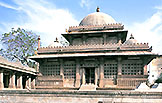 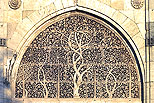 Rani Sipri's Mausoleum and a Jaali of Sidi Sayyid Masjid In the field of craftwork, the Jaalis (stone trellis work) that embellishes the large semicircular windows of Sidi Sayyid Mosque (1572), which employs an exquisitely delicate design on the motif of a tree spreading its branches, is especially celebrated.
Sultan Mahmud Beghara (r. 1459-1511), who brought the height of prosperity to the dynasty, constructed a lot not only in the city but also at the suburban Sarkhej where there remains a fine artificial lake with a complex of mosques, mausoleums, and palaces, moreover he also erected a new capital in Champaner. The reason that modern Ahmadabad became the center of modern design in India is that Balkrishna Vithaldas Doshi (1927- ), who trained in Le Corbusierfs atelier in Paris, established himself here in 1956, not only designing modernist buildings and teaching in the School of Architecture, Ahmadabad, but also accomplishing Le Corbusierfs Sanskar Kendra Museum (1957) and arranging Luis Kahnfs Indian Institute of Management, to be realized (1962-74) here. As for his own works, these include the Sangath (Doshifs own atelier, 1980), Gufa Art Gallery (2004) and so forth.
  Sanskar Kendra Museum and Gufa Art Gallery .
This is the ruin of an Islamic city, which includes many remaining buildings in Gujarat, western India.
It was also called Mahmudabad after his name, but the city began to decline after a quarter of a century and was destroyed by Humayun of the Mughal Dynasty in 1536, being abandoned to the jungle.
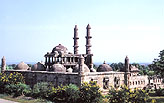 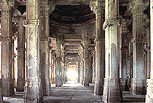 Jami Masjid (Friday Mosque) in Champaner Even though the largest mosque, the Jami Masjid (Friday Mosque, 1508), was widely influenced by the mosque of the same name in Ahmadabad, it attained to more accomplished and three-dimensional architecture, putting two slender Minarets standing in front of its facade at the height of 36m and being surmounted by a true dome (the other domes are corbelled ones) above a high three-story space in the center. In addition, its entrance pavilion is excellent. The Borah Mosque (Sahar-ki Masjid) emphasizes more the composition of a long horizontal worship hall and highly soaring vertical minarets. There is also the Nagina Masjid and the Kevra Masjid. All three were constructed in the middle of the 16th century, which corresponds to the early phase of the Mughal Dynasty. These mosques do not possess courtyards and their insides were built with a post and beam structure without arches, showing noticeably Hinduistic sculptural shapes at the pedestals of Minarets and the brackets of windows.
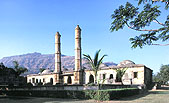
.
Jaunpur is a city about 60km northeast of Varanasi, Uttar Pradesh, in north India. Although its origin goes INDEX to the 11th century, it was annihilated by the inundation of the Gumty River. In 1359, Firoz Shah Tughluq of the Delhi Sultanate reconstructed it as a fortress against the sultan of Bengal, surrounding it with ramparts.
As the Tughluq Dynasty became weakened by the raid of Mongol army in 1398, Malik Sarwar, who had been designated by Firoz Shah as the governor, declared himself independent and established the Dynasty of Sharqi, which signifies the eEast.f
 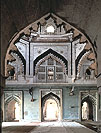 Pishtaq of Atala Masjid and Interior of Jami Masjid
At present, there remain few, but brilliant, mosques and mausoleums, to be referred to as the Jaunpur Style, are scattered around the city. Those mosques are on the Four-Iwan plan of the Persian-type, modeled on its first example in India, Begumpuri Masjid (c.1375 of the Tughluq Dynasty) in Delhi, while those in Gujarat State are Arabian type. As for its structural system, its main worship space with true domes and barrel vaults is coexist with the Indian traditional post and beam system (particularly in its cloisters), and their walls are embellished in an archaic manner. Atala Masjid (1408) represent such features is so called because of its construction by destruction of a Hindu Temple dedicated to the goddess, Atala Devi. A smaller scaled Lal Darwaza Masjid (1450) and the largest Jami Masjid (Friday Mosque, 1478) are also alike. The latter is on the 6m high podium and its courtyard is surrounded with two storied cloisters, the lower floor of which is occupied with shops and inns. Its Pishtaq attained as high as 26m.
 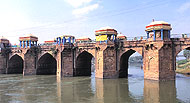 Lal Darwaza Masjid and Akbari Bridge, Jaunpur
After the reconquest of the city by the Mughal emperor Akbar in 1559, the Governor Munim Khan constructed a bridge on the Gumty River, which is the most important stone bridge in India, the Akbari Bridge (1568). It is said that an Afgan architect Afzal Ali designed it. Every pier of this 200m long bridge has a chatri on the top to provide a good view and resting facility for citizens. .
Mandu is the ruins of a Islamic city in Madhya Pradesh, middle India. After that, Mandu thrived for more than a century, erecting mosques, mausoleums, and palaces, in what is to be called the Malwa Style, but it was annexed by the Gujarat kingdom in 1526. It would be subjugated by Mughal Empire in 1566 and after the capital of the region returned to Dhar under the rule of the Marathas, it would fall into a ghost town.
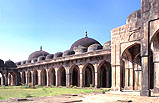  Jami Masjid and Mausoleum of Hoshang Shah, Mandu Although starting from the transplantation from the Tughluq Dynasty of Delhi, the architecture of Mandu is described as eIndian functionalismf because of its lack of decoration and its simplicity, fortitude and structural expressionism. The mosques are all simple Arabian type, lacking even a minaret, and their hypostyle worship rooms and cloisters surrounding a courtyard are built continuously and homogeneously.
Like the two extant mosques in Dhar, the early Dilawar Khan Mosque (1405) and Malik Mughis Mosque (1432) were built reusing dismantled components from Hindu temples, so they are composed with an Indian traditional post and beam structure and mostly corbelled domes.
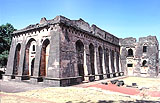 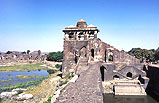 Hindola Mahal and Jahaz Mahal, Mandu There remain also numbers of secular buildings like the Hindora Mahal (1425), which shows a sturdy arch structure. In contrast to that, the Jahaz Mahal (Shipfs Palace) shows the masterly formation of space and graceful shaping. In spite of the loss of glazed tiles, it indicates Islamic yearning for paradise as a pleasure palace facing a delightful artificial lake. There are also numerous mausoleums, palaces, madrasas, caravanserais, gates, and cisterns, but the seven storied eVictory Tower,f which is said to have soared in height to 45m, collapsed, leaving only its foundation. In the court of Mandu, the art of miniature developed its distinctive style, even though under the influence of Persia, and founded a school of its own, which is represented by gNimatnamah (1495-1505, India Office Library, London) depicting epicurean culinary art. Among the people, excellent Jaina miniatures were produced, such as the gKalpa Sutrah.
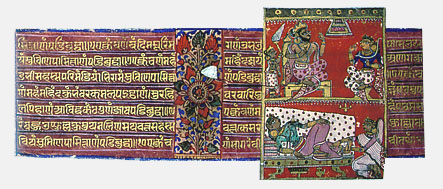
.
Gulbarga is an Islamic city in the north of Karnataka State, south India.
Tughluq Dynasty of the Delhi Sultanate constructed a new city of Daulatabad in the Deccan, southern India, and transferred its capital there from Delhi in 1327, but returned to Delhi three years later.
Gulbarga flourished for 80 years, being the center of Islamic culture in southern India, until the relocation of the capital to Bidar in 1424.
 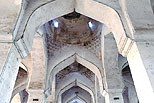 Jami Masjid (Friday Mosque) in Gulbarga It is best represented by the Jami Masjid (Friday Mosque, 1367), which stands in front of the massive fort, Bala Hisar, and is said to have been designed by the Persian architect Rafi ibn Shams. Some scholars say that the mosque was built in the early 15th century.
This mosque generated an austere architecture with pure solid geometry, completely different from traditional Indian architecture thereby, transforming the central part, usually a courtyard, into an interior space, and laying systematically 80 large, medium, and small sized domes and 27 pointed barrel vaults on the whole continuous arcades of pointed arches.
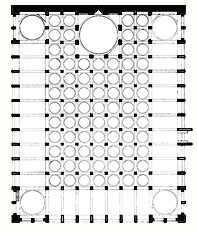 Plan of the Friday Mosque, Gulbarga,1367
Outside the city, there is the eHaft Gumbazf (Seven Tombs), which displays the developing process from an archaic hemispherical dome on tapering walls to a double domes on the two storied Firuzf Tomb. In addition, there are two Dargahs, the Shah Bazar Mosque, a caravanserai, a stable, and so on.
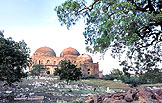 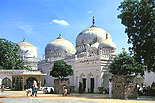
.
Bijapur has the largest architectural heritage in southern India. It is located in the north of Karnataka State, and its name derives from the ancient Hindu name, Vijayapura, meaning the ecity of victory.f Bijapur was the capital of the Adil Shahi Dynasty, established by the governor of Belgaum, Yusuf Adil Khan, first of all among the eFive Deccan Kingdomsf (Bijapur, Berar, Ahmadnagr, Bidar, and Golconda) disunited from the Bahmany Dynasty in the 15th-16th centuries. The capitalfs name is also used for the name of the state. Bijapur was the most long lasting among the five kingdoms, thriving for two centuries, until its destruction by Mughal emperor Aurangzeb in 1688. The city suffered only a little destruction in warfare, so it demonstrates very well the elliptic city formation with the central citadel and surrounding ramparts and moats reaching up to 10km and the architecture of the late (matured) Deccan Style. However, we cannot accurately discern the full estent of the city planning. Its edifices are decorative and highly developed in teerms of structural technology, matching that of the mature Mughal architecture of northern India. Its special features are the bulbous dome, lower part of which is wrapped with lotus-petal-like elements, numerous turrets with miniature domes on the top standing on the roof instead of Chhatris, and the Mihrabs of mosques as small octagonal or decagonal rooms.
 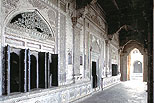 Ibrahim Lauza (complex of mausoleum and mosque), Bijapur
The Jami Masjid (Friday Mosque, c.1570) is an early example of the style, which has an Arabian type hypostyle hall crowned with a symbolic dome. Its interior shows a graceful and pleasant geometric rhythm by continuous arcades and small domes.
 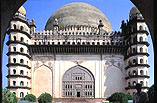
The summit of architectural achievement is reached in the Gol Gumbaz (1659), the Mausoleum of Muhammad Adil Shah II who was the successor of Ibrahim Adil Shah II. (Gombad is called Gumbaz in this region.)
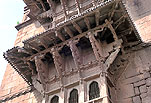 
And then, there is a peculiar building in the city, a tower gate, which is referred to as the Mehtar Mahal, showing a wooden-like structure and decoration like a piece of Hindu architecture. Other than that, there are numerous fort ruins, palaces, mosques, tombs, baoli (reservoirs), and so forth, scattered around. .
Sasaram is a city in Bihar, eastern India. Afghan origin Sher Shah Sur increased in force, making Sasaram his base, then declared independence from the Lodi Dynasty of the Delhi Sultanate in 1535, establishing the Sur Dynasty. In 1540, he defeated Humayun of the Mughal Empire and held hegemony in northern India entirely.
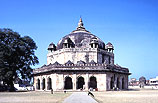
Sasaram is important as a historical stage just before the development of Mughal architecture, since there are the mausoleums of three generations of monarchs designed by the architect, Aliwal Khan, who had studied in Delhi. The first is that of Hasan Sur Khan (c.1535), father of Sher Shah. It adopted the octagonal plan, which had been established in Delhi, with vertical columns instead of tapering, and crowned with a dome of 19m in diameter.
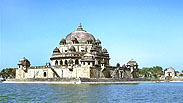  Panorama and Cloister of Sher Shah's Mausoleum
As for the Mausoleum of Sher Shah (1545), it was erected on a square podium on an island-like square stylobate, created in an artificial lake, in the same form as Hasan Khanfs Tomb. It attains 46m in height and the inside diameter of its dome is larger than Hassan Khanfs, reaching 22m, the inner volume of which is the largest in northern India.

Though the mausoleum of his son, Salim Shah (c.1550), was planned to be much larger on another lake, it ended incomplete, leaving only its basements. |
|
.
Though the art of the Mughal Dynasty formally refers to about 320 years of mature Indo-Islamic Art during the Mughal age, following Delhi Sultanate Art and making Agra and Delhi the capitals, it substantially indicates about 130 years of the architecture, gardening, painting, and crafts from the first emperor Babur to the sixth Aurangzeb.
Invading India from Kabul, Babur defeated the Lodi Dynasty and founded the Mughal Dynasty in Agra in 1526. Mughal means Mongol, deriving from the fact that Babur was a descendant of Timur and Chinggis Khan of the Mongol Empire.
  Miniatur from "Babur Nama" and Nishat Bagh in Shrinagar The second emperor Humayun fled to Safavidfs Persia for 15 years after his defeat by Sher Shah, and then returned to Delhi in 1555, bringing a large number of Persian architects and painters with him, greatly contributing to Mughal art afterward, encouraging its Persian character.
When Humayun died in a sudden accident, Akbar the Great (r. 1556-1605) succeeded to the empire for half a century and expanded it to the whole of India, developing Mughal art remarkably.
He aggrandized the capital Agra, constructing the Lal Qila (Red Fort) with red sandstone. He also promoted the union of Hindus and Muslims for the stabilization of the empire and applied this principle to architecture too. The formation of mausoleums with a tomb as a garden pavilion in the center of a vast square garden is a unique Indian architectural form, which excellently expresses the Islamic yearning for Paradise.
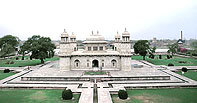
In the age of the fourth emperor Jahangir (r. 1605-27), the Tomb of Itimad al-Daula (1628) in Agra foreshd the Taj Mahal as a white mausoleum.
The Mughal Dynasty reached the high watermark of its culture in the age of the fifth emperor Shah Jahan (r.1628-58), embellishing the empire with luxurious white marble palaces, mausoleums, and mosques in comparison with Akbarfs red sandstone.
 
The sixth emperor Aurangzeb (r. 58-1707) did not like pomp; therefore his tomb (1707) in Khurdabad is extremely simple without even a roof. .
Agra is an ancient city in Uttar Pradesh, northern India, and an Islamic treasure house of the architectural legacy of the Mughal Dynasty. It is connected with Delhi, which is 200km north, by the Yamuna River, forming a tight relationship, when either city was capital. Compared to Delhi, which has a history from remote antiquity, Agra commenced in the age of the Lodi Dynasty of the Delhi Sultanate. Babur (1483-1530), who established the Mughal Dynasty in 1526, intended to extend the city greatly, fixing it as his capital. However, as he died comparatively young and his successor Humayun also died in an accident, it was the third emperor Akbar who actually constructed the enlarged capital, so it was also called Akbarabad after his name.
The city was encircled with ramparts, and the fort (1565-73) facing the Yamuna River is also encircled with sturdy red sandstone walls, from which it is called Lal Qila (Red Fort) just like the later built Delhi Fort.
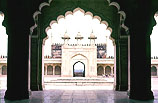  Moti Masjid in the Fort and Ram Bagh, Agra The first emperor Babul loved gardens and brought the garden-form of eCharbaghf of the Timur Dynasty into India. His successors vied with each other in building gardens along the Yamuna River and brought up Agra a garden city equaling Shiraz, Iran. The Ram Bagh, which Babur first made and later been altered, is the first Mughal garden.
 Riverfront Garden City, AGRA ( from Ebba Koch, The Complete Taj Mahal, 2006, Thames & Hudson )
Although most of those gardens along the river were noblefs houses, large Charbaghs, which embrace a tomb in the center as a garden pavilion, were opened for public. The mausoleum and its garden of Itimad al-Daula (1628), who was the father of Nur Jahan, the wife of the fourth emperor Jahangir, was a typical of that. The tomb, embellished with delicate inlaid works using colored stones despite a white house of white marble wholly, is a jewel of Mughal architecture.
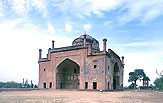 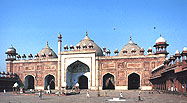 Chini-ka Rauza and Jami Masjid, Agra
The climax of the tomb gardens in this type was the garden of the Taj Mahal, which Shah Jahan constructed for his deceased favorite wife, Mumtaz Mahal, and the garden of the other side of the river, the Mahtab Bagh (Moonlight Garden). The tomb is considered as the supreme masterpiece of Indo-Islamic architecture due to its figure of pure whiteness with the highness of refinement and superb proportion. .
Delhi is the capital of the Republic of India and the name derives from the city of Dilli that was constructed by the king of Kanauj, Dilu, in the 1st century of B.C.E. The people in the capital still call it Dilli to this day.
After the invasion of the army of the Ghor Dynasty from Afghanistan, Delhi commenced its new history as an Islamic city. In greater Delhi, a new city was constructed in succession, and were later called altogether eThe Seven Cities of Delhi.f
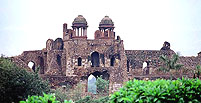 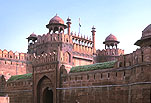 Gates of Purana Qila and Lal Qila, Delhi
Though the Mughal Dynasty, which started in 1526, relocated its capital to Agra,@the second emperor Humayun commenced constructing the sixth city, Dinpanah, in greater Delhi in 1534.
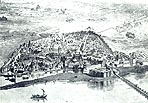 Bird's-eye picture of Shahjahanabad
Although the third Mughal ruler Akbar erected the mausoleum of his father Humayun in Delhi, he did not settle his capital there, relocating from *Agra to *Fatehpur Sikri and Lahore in turn.
 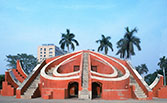 Jami Masjid and Jantar Mantar, Delhi
The Jami Masjid (Friday Mosque, 1656) is a typical Indian mosque, together with that of Lahore, with three grand domes as a piece of sculptural architecture. The Jantar Mantar (Observatory) was constructed by Sawai Jai Singh II, the maharaja of Jaipur, in 1724. The shapes of them are extremely conspicuous in Delhi. .
This is the tomb and garden of the second Mughal emperor, Humayun(r.1530-40, 1555-56), built in 1571 in Delhi, the capital of the Indian Republic.
 PLAN of Humayun's mausoleum, Delhi, 1571 That is: a square planned tomb as a garden pavilion is set on a high platform in the center of a vast Charbagh. The tomb is a four-faced building open to four directions by means of Iwans and crowned with a white marble dome (it was possible only after using Indian white marble, which is resistant to water and acid) and enlivened with chhatris on the roof. The dome is double-shelled, providing a ceiling at a height suitable for the interior, and a roof at a height desirable for the exterior view. The tomb itself is also doubled, with a cenotaph on the ground floor and a true sepulcher underground.
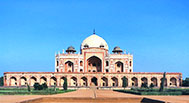  General view and Roof Terrace of Humayun's Tomb, Delhi Due to the great artistic success of this mausoleum built in 1571 and designed by the Persian architect, Mirak Mirza Ghiyath, most of the later mausoleums in India followed this form and its zenith was the Taj Mahal.
.
Fatehpur Sikri is the remains of an Islamic city in Uttar Pradesh, west of northern India.
 Friday Mosque in Fatehpur Sikri
The Jami Masjid (Friday Mosque, 1571), one of the four great mosques of the Mughals, created a crystal-clear interior space with a post and beam structure of red sandstone rather than focusing on its outward appearance by using a great dome.
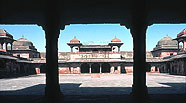 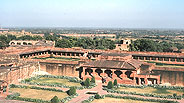 Jodh Bai's Palace and Diwan-i-Amm, Fatehpur Sikri
The palace quarter has the same directional grid system as the mosque quarter, in which grid all buildings are arranged in parallel with each other. Most of them were erected of stone, but in the wooden-like eAkbar Stylef without true domes and arches, such as Jodh Baifs Palace (1569), Panch Mahal (1570), and Diwan-i-Am (Public Audience Hall, 1570).
Akbar abandoned this city in 1585 to relocate his capital to Lahore, the reason for which is said to have been the deficiency of water. However, since the city did not suffer the maelstrom of wars, both quarters are in a superb state of preservation. .
This is a historical site, west of Agra in Uttar Pradesh, northern India. Sikander Shah, a Sultan of Lodi Dynasty, the last of the Delhi Sultanate, constructed a new city here in 1492, hence its name, but the remains are scarce.
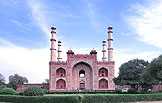 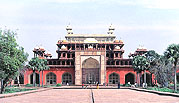 Gate and Mausoleum of Akbar, Sikandra
120 years later, in 1613, after that, the mausoleum of the third Mughal emperor, Jala-ud-Din Akbar (r. 1556-1605), was constructed here. The tomb is set in the center of the great Charbagh, following the form of the Mausoleum of Humayun. The area of the precinct comes up to 48 hectares, four times grander than the latterfs, and is the largest Charbagh in the world.
 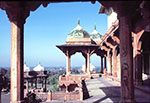
As the commencement of the construction was in 1603 during Akbarfs lifetime, it can be said that his intention to reconcile Muslims and Hindus for the sake of the empire was also applied to his architecture. Here, through the fusion of Hindu architecture based on the post and beam structure and Islamic architecture based on pure geometry, an unprecedented striking mausoleum came into being. .
Shrinagar is the capital of the state of Jammu and Kashmir, northern India. It is on the high altitude of 1,593m, having developed a cold districtfs culture, which is rare in India. The special features of the Kashmir style are a double-tiered sloping roof, a style derived from a lot of rain, and a gable containing a trefoil arch over the doorway. It can be thought that the medieval Hindu stone temples inherited them from the ancient Buddhist wooden temples, and afterward they were transferred to the early-modern Islamic wooden mosques.
 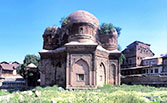 Pandrrethan Temple and Tomb of Zain al Abidin's Mother, Srinagar
Though there remains no ancient structure, in terms of the medieval Hindu architecture, there is a stone Shiva temple (10th century) in a southern suburb, Pandrethan. It is in a typical Kashmir style and has a ceiling of fLaternendeckef looking like a wooden form.
 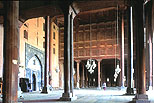 Shah Hamadan Mosque and Friday Mosque, Srinagar
Wooden mosques with pointed turrets instead of round domes exist only in Kashmir. The Shah Hamadan Mosque (first constructed in 1395) is a one-room-type mosque, and the largest mosque, Jami Masjid (first constructed in 1585), has the Persian Four-Iwan type plan. While both of them were repeatedly destroyed by fire and reconstructed, the latterfs interior with 370 thick cedar columns is spectacular.
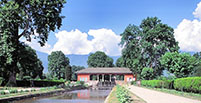
In accordance with the stabilization of Mughal rule, the Court began to move to Shrinagar in summer to escape the summer heat in Delhi, constructing many Mughal gardens around Lake Dal. Especially the Shalimar Bagh (c.1620) and the Nishat Bagh (1632), based on Charbagh (quadripartite garden), are prominent among the Islamic gardens in the world. In both of them, water from the mountain flows through water channels, fountains, and chadars (stone water chutes) in a central axis toward Lake Dal. .
The Taj Mahal is a mausoleum in Agra in Uttar Pradesh, northern India, a famous piece of Islamic architecture that was constructed by the 5th Mughal emperor, Shah Jahan (r.1328-58), in mourning for his beloved wife, Arjumand Banu Begum. The abbreviation of her nickname, Mumtaz Mahal, which meant the eChosen One of the Palace,f became the popular name for the mausoleum.
 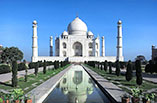 Taj Mahal, Agra
Its construction proceeded from 1632 to 1642 and it was in 1647 that the precinct, including its enormous garden, was totally completed, making it the final spot among the large gardens along the Yamuna River flowing through Agra. This was a completely geometric regional plan, which stretches from the commercial area, which was of the same extent as the Charbagh, to the Mahtab Bagh (Moonlight Garden) on the other side of the river, accounting for 1,500m in length by 300m in width.
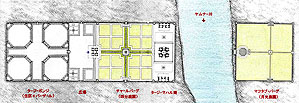
The tomb itself, accompanied by a red sandstone mosque in the west, and a similar guesthouse in the east, was made entirely of white marble from the base to the top of the dome. The splendid inlaid work on its walls was restrained in density in order to maintain the image of the completely white mausoleum. The intense desire to make it the eternal monument of the Mughal Dynasty can be seen, for example, in the colossal double-shell dome (64m in height) that contains a vast empty space, larger than the central tomb chamber itself, and four minarets (42m in height), redundant on a mausoleum, built for glorification.
Though there is a manuscript suggesting that the architect was Ustad Ahmad Lahori, who had participated in the design of the Delhi Fort, it is assumed that the emperor himself played a large part in the design. He was the greatest builder in the history of India, constructing, in addition to the Taj, the new city of Shahjahanabad (currently Old Delhi), the Delhi Fort, and the largest mosque in India (Jami Masjid in Delhi), and the reconstruction of many palaces in the Agra Fort and Lahore Fort. |
|
.
A stepwell is a kind of hydraulic architecture in India, referred to as Baoli in northern India, as Vav in western India. Seeing divinity in water as the source of life, Indians used to consecrate the area around watersources such as seas, rivers, lakes, reservoirs, and even wells as sacred aquatic spaces. Instead of building roofs, they constructed steps reaching the waterside and often added small shrines close by, so those places look like religious facilities.

These stepwells were often constructed as philanthropic works for people by a king or particularly by a queen. When their structure is carved exquisitely as at temples or palaces, they become luxurious underground architecture of a rare kind in the world.
   Stepwells of Bundi, Vikia, and Adalaj
Though simpler ones had been constructed in various places since ancient times, they are most numerous from the mediaeval period to the early-modern times in arid west India, which embraces the Thar Desert. The Islamic monarchies continued to construct stepwells. The best representative is the Ruda Stepwell in Adalaj and the largest is the Rani Vav (Queenfs Stepwell) in Patan.
 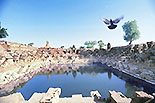 Stepwell in Patan and Kunda in Modhera .
A chhatri is an architectural decoration that developed and became quite popular in Indo-Islamic architecture, particularly under the Mughal Dynasty. It is a small turret with stone columns, principally four, supporting a dome with Chajja (stone protruding eaves) under the dome.
 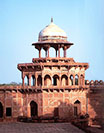 Simple Chhatri and Grand Chhatri While western Islamic architecture supports domes with walls, India, which had started with wooden architecture and adhered to a wooden-like post and beam structure, created such a light architectural component, using stone columns, to embellish all kinds of buildings, on the roofs, walls, and towers. Even a large chhatri with six, eight, or twelve columns on a polygonal plan has an appearance of lightness.
Because its shape resembles an umbrella, its name derived from the Sanskrit eChattra,f meaning umbrella. As it concurred with Indiansf sense of beauty, it was used even in Hindu Rajput buildings and colonial architecture of Indo-Saracenic style.

.
Chahar Bagh in Persian or Charbagh in Urdu, literally meaning efour gardens,f indicates a geometrical square garden surrounded with walls or buildings and divided into four quarters by waterways or walkways. This quadripartite garden is the principal form of Islamic garden, which was created in Persia and widely propagated from Spain to Central Asia. It developed in India in particular, especially under the Mughal Dynasty.
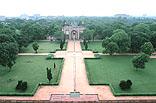 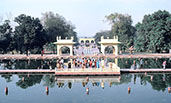 Gardens of Humayun's Tomb in Delhi and Shalimar in Lahore
In ancient Persia, an enclosed garden was called a ePairidaeza,f which is the origin of the word Paradise. Since this form was connected with the Islamic yearning for Paradise, the celestial Paradise promised for pious Muslims came to be expressed in this style.
 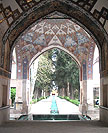 Plan of Lion's Patio in the Alhambra and Fin Garden in Kashan
Among numerous Charbaghs, the best-known ones are the Lionfs Patio in the Alhambra, Spain, and the Fin Garden in Kashan, Iran, with a slightly variant form.
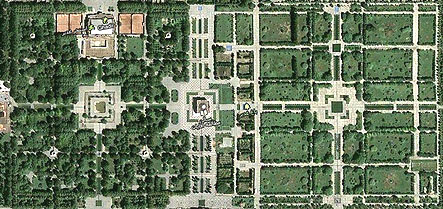
A double Chahar Baghs substantially following the plan of Shalimar Garden, Lahore ( Gadir Bagh, from foogle Map ) .
The Rajput are said to be the descendants of people who came into India about the 5th century from Central Asia and indigenous people at that time. They have been brave warriors, believing themselves to belong to the ancient Hindu Kshastria class. Rajput art indicates, in a broad sense, the arts of various Rajput peoples from ancient times to early modern times, including those of the Chandella Dynasty in northern India and the Princely state of Hyderabad in southern India. However, such a definition is too broad and nonspecific. Therefore, in the usual history of arts, it indicates, in a narrow sense, Rajput art that developed in various Hindu states in western India after the 16th century.
Despite being subjugated by the Mughal Dynasty, those kingdoms could keep their Hindu religion and the rights of self-government, and after the weakening of the Mughals they survived as half independent Princely states under British rule.
  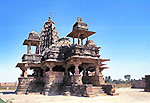 Hindu Temples in Brindaban, Orchha, and Bijolia Architecturally, the external appearance of buildings, gradually influenced by Islamic art, using domes, Chhatris, Jalokas, and Bangardar roofs, came to resemble the Indo-Saracenic style of colonial architecture.
Although Hindu temple architecture had declined under the rule of the Delhi Sultanat, it revived thanks to the tolerant policies of Akbar of the Mughal Dynasty. They constructed temples such as the Govindadeva Temple (1590) in Brindaban and the Chaturbhuja Temple (c.1700) in Orchha, both of which have mosque-like interior spaces with an arch and dome structure. Though there had been no custom to build tombs in India owing to the idea of transmigration (reincarnation), Rajput kings began to erect their own mausoleums with a dome like Mughal tombs, after the influence of Islamic architecture. One of the biggest mausoleums is Baktawar Singhfs Tomb in Alwar. Those tomb buildings are also called Chhatris.
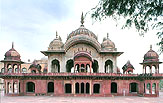 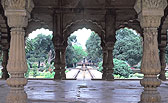 Bakhtawar Singh's Tomb in Alwar and Keshav Bhavan in Deeg As for Rajput forts and palaces, while the forts of Jodhpur, Jaisalmer, and Bikaner have palaces that are connected asymmetrically and irregularly, palaces in and after the 18th century, such as in Deeg or Alwar, took a geometrical formation surrounding a Charbagh, like Mughal palaces. The Jag Niwas Palace (1754) in Udaipur was built as if floating on a lake, following the Islamic yearning for Paradise.
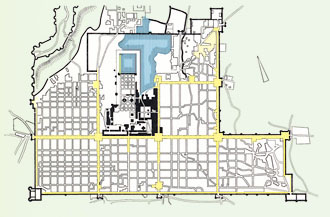 City Plan of Jaipur
What deserves special mention is the City Planning of Jaipur, in which Indian traditional thought and Islamic geometrical composition are combined. It is the most remarkable city planning in the history of India.
In the 19th and 20th centuries, Maharajafs palaces in various states gradually westernized and, through British architects, evolved the Indo-Saracenic style. .
Goa is a historical site in middle India and the first European colonial city in the country. It is a museum town containing many Christian churches and monasteries. Existing buildings are in the Renaissance and Baroque styles, built in the 16th and 17th centuries, when the city prospered to the degree that it was called the eGolden Goa.f However, as stones of good quality were unobtainable in Goa, they were not built of stone but laterite (hard reddish soil) and finished with plaster. In the Renaissance style, there is See Cathedral (1619), which is the largest building in Goa, and the Convent of St Francis of Assisi (1661). And in the Baroque style, there is the Basilica of Bom Jesus (1605) and the Church of St Cajetan (1651), which is modeled on St Peterfs in Rome. Each church has a magnificent wooden altar produced by dint of the traditional woodcarving of India.
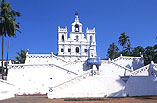 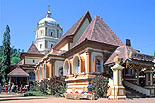 Christian Church in Panaji and Hindu Temple in Ponda In the middle of the 17th century, the seat of government was transferred, due to an epidemic, to New Goa (the current state capital, Panaji) on the cost. The town, in which only religious buildings remained, was called Old Goa. After that, the style of colonial architecture in India changed into Neoclassicism and Gothic Revivalism, both of which were led by the British.
Because the Portuguese did not permit non-Christian religions to exist in Goa, Hindus resided in villages in the surrounding mountains and erected temples there. As architects and craftsmen were Goans, the temples were constructed in a rare style in India, mixing Hindu architecture and Christian architecture, such as the Shanti Durga Temple (1738) at Ponda. .
Amritsar is a city in the northern part of Punjab, northern India, known as the most important sacred place for Sikhism, where the head temple exists. Sikhism is a religion founded by Guru Nanak(1469-1538) based on uniting virtues of Hinduism and Islam. It spread all over India, though based on Punjab.
 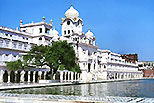  Hari Mandir (Golden Tample) in Amritsar
A Sikh temple is referred to as a Gurdwara. Because, as a later religion, it did not develop its own original style, it usually follows the style of Mughal palaces finished in white but with more decorative features; and like mosques, does not have idol sculptures.
In contrast to Hindu temples, the Golden Temple, which one reaches by crossing a bridge, is quite open, the inner space of which is continuous to those of surrounding pond and terraces. This overall formation of the precinct is an excellent environmental art, the character of which Gurdwaras in various places follow. .
Mumbai is the capital of Maharashtra state, middle India, and is the largest commercial city in India. It was first colonized by Portugal in the 16th century, then by Britain in the 17th century. It developed remarkably in the 19th century as Bombay, but in 1955, after the independence of India, it was renamed its old name, Mumbai. When Henry Bartle Frere took office as the governor of the Bombay Presidency in 1862, he entirely removed the old ramparts of the old town and constructed a series of public facilities at their sites in the Gothic style. It is best represented by the Library of Bombay University (1878) designed by George Gilbert Scott, the clocktower of which, called Rajabai Tower, became the symbol of the city.
 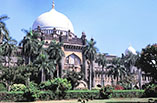 Bombay University and Prince of Wales Museum, Mumbai
Numerous colonial buildings by British architects stand in rows in the center of Mumbai and the last great monument is the Victoria Terminus built in 1887 (now renamed Chhatrapati Shivaji Terminus) designed by Frederic William Stevens (1848-1900). It was erected completely under mediaeval aesthetics down to its rich carvings in detail.
  Eros Cinema and New India Assurance Company, Mumbai
In the 1930fs just before the Independence of India, the waves of Modernism began to come and Art Deco architecture was brought to Bombay. In strong contrast to the former historical styles, great numbers of commercial buildings were erected in free design using curved lines by burgeoning Indian architects, accompanied by new sculptures and craft works. The most important buildings in that style are the Eros Cinema (1938) and the New India Assurance Company (1937). .
Indo-Saracenic is the architectural style diffused from the 1870fs to the early 20th century for colonial buildings in India, adding the elements of Indian traditional architecture, particularly Mughal architecture, to the base of Victorian Gothic style. The British government, proceeding to colonize India, constructed governmental and public buildings in European classical styles regardless of Indian local climate and traditions. However, after the Indian Mutiny (1857-58) occurred against this tendency of the ruling system, the British government came to introduce local architectural traditions, especially the Islamic architecture of the Mughals, to colonial erections. As it was the age of craze of Gothic Revival, British architects in India made this the base to which they added domes, Chhatris, and Bangardar roofs to form the external appearance of Indian taste.
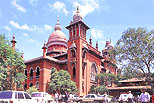
Islamic architecture had been called Saracenic architecture in Europe until the 19th century, hence came the strange name of eIndo-Saracenic style.f And yet Indians accepted it in a sympathetic way as what British architects represented Indian nationalism, and it was diffused throughout the country. The INDEXground of that was the progress of the research of ancient buildings since the foundation of the Archaeological Survey of India on the one hand, and the first elucidation of the architectural tradition of India by the publication of the gHistory of Indian and Eastern Architectureh (1876) written by James Fergusson on the other hand.
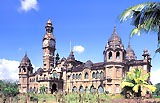  New Palace in Kolhapur and Muir College in Allahabad The precursors of this style were Charles Mant (1840-81), who designed the New Palace of Kolhapur (1881) and William Emerson (1843-1924), who designed Muir College (1886) in Allahabad. The reason of that Islamic architecture was selected as the Indian tradition was that Mughal architecture based on arches and domes was considered more compatible with European architecture than Hindu temples based on the post and beam structure. In spite of that, Robert Fellows Chisholm (1840-1915) mastered Indian traditional architecture other than Islamic, and made a compromise between that and Western architecture. It is best represented by the Napier Museum (1880) in Trivandrum absorbing south Indian tradition of wooden architecture.
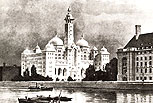
Eventually, the word eIndo-Saracenic Stylef was widely used for colonial architecture that adopted the elements of even Hindu or Buddhist architecture. The work that reached the summit of this style is the High Court (1892) in Madras (now Chennai). .
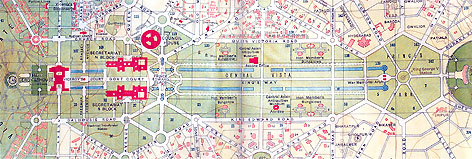
Although the British government, which had overthrown the Mughal Dynasty, had made Calcutta the capital for a long period, King George V declared in 1911 the construction of a new capital in the central districts, that is to say the eighth city of Delhi, for the purpose of repressing the independence movement in Calcutta. The site chosen for the new Imperial city was a waste land south of Shajahanabad and the architects commissioned to make a city plan and to design the main buildings were the British architects, Edwin Lutyens (1869-1944) and Herbert Baker (1862-1946).
  Rashtrapati Bhavan (old Viceroy's House), New Delhi They planned a verdant city that was functional despite being built in a historical style, combining an axial plan grounded on Baroque-like hexagonal grids and the concept of the Garden City, a new theory for city planning at that time. Architecturally, both of them were classicists, but also adopted the Indo-Saracenic Style, accepting the viceroyfs requirements. Lutyens designed the Viceroyfs House (now Rashtrapati Bhavan, 1929), India Gate (1931), and so on, and Baker designed the Secretariat (1931) and the Legislative Building (1920). As capital designs before Modernism, New Delhi, completed in 1931, ranks with Washington, D.C. in the USA and Canberra in Australia.
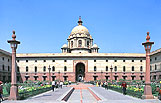  Secretariats and Cathedral Church of Redemption, New Delhi There are many late colonial buildings in the city, such as the Anglican Cathedral (1935) designed by H.A.N. Medd. The ornamentless Garrison Church of St Martin (1930) designed by Arthur Gordon Shoosmith, a disciple of Lutyens, is the first work of modernism in India. Currently, Delhi is a metropolis with a population of 14 million, comprising eight historical cities from the first Lal Cot (Qutb district) and spreading to the greater urbanized area. Important facilities for arts include the National Museum and the Indira Gandhi National Center for the Arts in New Delhi. |

E-mail to: kamiya@t.email.ne.jp
